Three British ships and a US submarine that sank in the Java Sea during the second world war have been destroyed by illegal scrap metal scavengers, the Guardian can reveal.
The UK’s Ministry of Defence said it condemned the “unauthorised disturbance of any wreck containing human remains” and requested Indonesian authorities investigate and take “appropriate action”.
The commercial salvaging of war wrecks has caused significant upset among veterans, historians and governments who want to preserve the final resting place of sailors who went down with their ships.
A preliminary report from an expedition to document sunken ships, seen by the Guardian, shows that the wrecks of HMS Exeter, a 175m heavy cruiser, and destroyer HMS Encounter have been almost totally removed.
Using equipment that creates a 3D map of the sea floor, the report showed that where the wreck “was once located there is a large ‘hole’ in the seabed”.
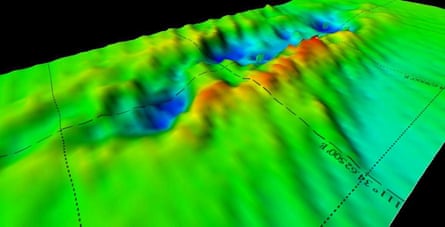
A 100m destroyer, HMS Electra, had also been scavenged, the report found, although a “sizeable section” of the wreck remained. The 91m US submarine Perch, whose entire crew were captured by the Japanese, had been totally removed, the report said.
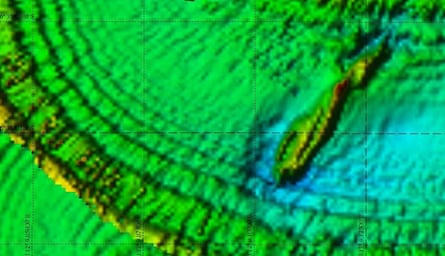
All four sank during operations in the Java Sea in 1942, when Japanese forces overpowered Dutch, British, American and Australian sailors. The battle was one of the costliest sea skirmishes for the allies during the war and led to the Japanese occupation of the entire Dutch East Indies.
The Ministry of Defence said in a statement that the British government had contacted Indonesian authorities to express “serious concern” and request they investigate and take “appropriate action to protect the sites from any further disturbance.
“Many lives were lost during this battle and we would expect that these sites are respected and left undisturbed without the express consent of the United Kingdom.
“It is British Government policy that our military wrecks are offered appropriate protection and management,” it said.
The news comes after the Netherlands defence ministry said this week that it had launched an investigation into the disappearance of three of its own shipwrecks, also in the Java Sea. “The desecration of a war grave is a serious offence,” it said in a statement.
That announcement appears to be based on the same preliminary report, which also mapped empty space where HNLMS De Ruyter, HNLMS Java, and HNLMS Kortenaer used to be.
The expedition had been sent to the Java Sea this month to take video footage of the underwater Dutch ships in advance of next year’s 75th anniversary of the Battle of the Java Sea.
Some 900 Dutch sailors died in the battle, including Rear Admiral Karel Doorman, a war hero in the Netherlands. Divers were planning to put a plaque on the vessels, which were located in 2002 – only to discover that they had vanished.
The story has caused outrage in the Netherlands, with De Telegraaf newspaper putting the story on the front page on Wednesday under the headline: “Mystery in the Java sea.”
The lost Dutch ships of the battle of the Java sea (1942) is frontpage news in the Netherlands. @telegraaf #WW2 pic.twitter.com/I7JTQlrTYX
— Klaas Meijer (@klaasm67) November 16, 2016
When the crew found the three Dutch vessels had essentially been removed, they decided to broaden the scope of the mission to examine other wrecks, the Guardian understands.
The British embassy in Jakarta was informed last week. Andy Brockman, an archaeologist and researcher in maritime crime, said the UK government had not done enough to stop undersea looting.
“My feeling is that the Ministry of Defence files the issue of taking active steps to protect historic Royal Navy wrecks under the heading of too difficult and too expensive,” he said. “However, I think it is becoming ever more clear that this attitude is not acceptable to the wider public, not least to veterans and their families.
“This latest example of commercially driven damage to what are maritime military graves should be a spur to international action, led by the governments of Britain, Australia, the Netherlands and the USA, over two thousand of whose sailors lie in the Java sea.”
In the ministry’s statement, it said that “given the vast locations of Royal Navy wrecks around the world, that there are limitations on what protection we can provide, but we will continue to work with regional governments and partners to prevent inappropriate activity on the wrecks of Royal Navy vessels.
“Where we have evidence of desecration of these sites, we will take appropriate action,” it added.
Exeter had a crew of around 700 men, most of whom were rescued by the Japanese to become prisoners of war. The Ministry of Defence said 54 men died when it sank.
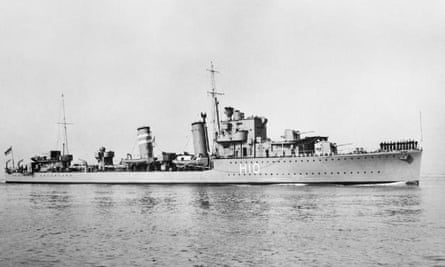
Encounter and Electra both had crews of 145 men, although they were significantly overloaded with sailors rescued from other ships sunk in the Java Sea. Eight men died on Encounter before it sank. Most of Electra’s crew are believed to have been killed.
Crews posing as fishermen and using long rubber hoses to stay underwater for hours have scavenged the waters around Indonesia, Singapore and Malaysia, locating the wrecks and stealing parts, including steel, aluminium and brass.
The potential worth of metal-built shipwrecks is estimated at hundreds of thousands of pounds. Some of the propellors, often the first items to be stolen, are made of phosphor bronze scrap metal, valued at over £2,000 per tonne.
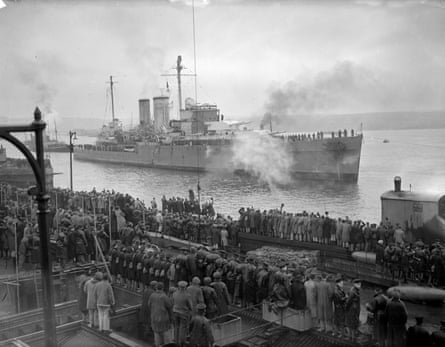
Brockman said the wrecks were the property of the flag state in which they were registered. Under the international salvage convention it is illegal to remove scrap without official permission, he added.
He said: “It’s like a cottage industry, apart from the fact the illicit salvage boats are dealing with substantial wrecks. Basically they use explosives and grabs to rip things apart. You get basis steel. In a single engine room you have a lot of non-ferrous metals, copper and brass, which have a premium on the scrap metal market.”
Last year the Malaysian navy spotted a vessel near the site of second world war shipwrecks and arrested 17 Vietnamese crewmen. Several other men were underwater removing parts. In a separate incident, a Vietnamese crew was caught with iron cutters and a crane.
In 2014, the wrecks of the HMS Repulse and HMS Prince of Wales and the resting place of more than 800 Royal Navy sailors off the coast of Malaysia were found to have been damaged by scavengers.
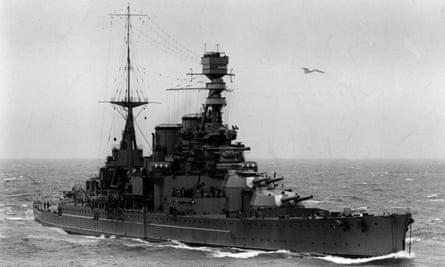
And when divers found that Australia’s HMAS Perth, also sunk by the Japanese in 1942, had been salvaged, Canberra was accused of trying to keep the news secret to avoid any potential diplomatic fallout between between Australia and Indonesia.
The US military has also sent several delegations to Indonesia to try to protect its wreck sites.
The Ministry of Defence has been accused of not doing enough following allegations that some of the 25 ships sunk in the North Sea battle are being torn apart. There has also been extensive scavenging of both German and British vessels sunk in the first world war during the battle of Jutland.
The war graves commission said on Wednesday that the wrecks were not formally designated as war graves. It said the 386 servicemen who died in the battle were commemorated on memorials in the UK. The figure includes those were rescued and who died in Japanese captivity.
Brockman described the battle in the Java sea as “not much known”, and said it was a crushing defeat for British, Australian, American and Dutch forces. A squadron of ships from the four nations was hastily assembled, he said, under the command of Rear Admiral Doorman.
He added: “Effectively it was a shambles. They had never trained together and their equipment was incompatible. They were basically massacred. They were trying to get back towards Ceylon in the face of the Japanese invasion.
“They ran into a crack Japanese cruiser squadron which outgunned and outmatched them and was trained in night fighting. All the vessels involved were sunk in one-and-a-half days. The wrecks are spread over the whole area of the Sunda straight [between the Indonesian islands of Java and Sumatra].”
‘I shall never forget the sight of Exeter going’
Lt Cmdr George Cooper wrote this account of HMS Exeter’s last action, which appeared in War Illustrated in 1946
For some unaccountable reason it was considered at headquarters that our best means of escape lay through the Sunda Strait to the westward, whereas the chances of doing this successfully were very remote in such enclosed waters. It would have seemed wiser to get away to the eastward towards Australia, as a chase in this direction would have drawn the enemy away from his fuelling bases, which he could not easily afford.
The following morning, Sunday, March lst, 1942, at 7.30, we sighted the topmasts of two Japanese heavy cruisers and turned south until they were out of sight, when we resumed our westward course. At 9.30, we sighted them again to starboard with a large destroyer, and shortly afterwards two smaller cruisers with five destroyers appeared on the port side. We turned to the eastward with our escorting destroyers, the British Encounter and the American Pope, to put the enemy astern.
For two hours we had a running fight with them. They straddled us many times but never hit us until at 11.30 one shell penetrated the boiler room. It was a shot in a million as it cut our one remaining main steam pipe.
The ship just came to a stop in all departments. The main engines stopped through lack of steam. The dynamos stopped. The turrets were motionless on different bearings. The steering failed. The inside became full of smoke as escaping oil fuel in the forward boiler room burst into flames. There was nothing we could do except sink her.
So the magazine valves were opened. The condenser inlets were allowed to flood the engine room, and watertight doors usually kept closed were opened. A pretty good inferno was going on down below as the fire spread. She started to list slightly to port, pouring black smoke out of her funnels. I thought she looked defiant, like a stag at bay. Men were cutting down carley floats and flotanets, casting timber adrift, turning out boats.
The Japanese were starting to hit us now as the range closed in. The after superstructure caught fire and the whine of projectiles sounded like the Ride of the Valkyries. She was getting lower in the water and heeling more. The inside had been completely evacuated; no one could live down there. At the bottom of the ladder leading to the upper deck were a lot of people, all quite calm. She was very nearly stopped, and men were leaving in dribs and drabs. As they went they drifted away astern. Then I climbed over the side and jumped into the water.
A little later, a destroyer closing on the starboard beam fired a torpedo. It was a good shot as it hit her right amidships. The old dear shuddered a bit. She seemed to shake herself from bow to stern. She must have had very little positive buoyancy left as she went right over to starboard until her funnels and masts were horizontal. Then, heaving herself up in a final act of defiance, she disappeared in a swirl of water, smoke and steam.
I had never seen a ship sink in day time before. I had seen twelve ships sunk in a convoy in the Atlantic one wild night in October 1940. One of these I saw break in half and the two halves rear up in the air and disappear in twenty seconds. But darkness had spared me the most terrible sight for any sailor – a ship’s final lurch below the waves when the ocean floods inside and gets her down forever.
So I shall never forget the sight of Exeter going. It did not seem real. We had lived in that ship for a year. We had our cabins and messdecks there, all our private belongings and treasures, mementos of home, books, photographs.I remember throwing my large Barr and Stroud binoculars on the deck before I went over the side. What a waste, I thought, yet a bagatelle compared to the loss of a fine 8-inch cruiser with a score that included the Graf Spee off the River Plate.
Anyhow, we all gave her three cheers as she went. You could hear the faint cheers rippling over the water.”
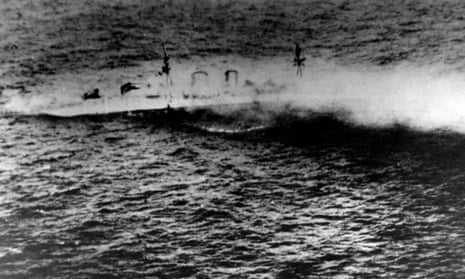
Comments (…)
Sign in or create your Guardian account to join the discussion